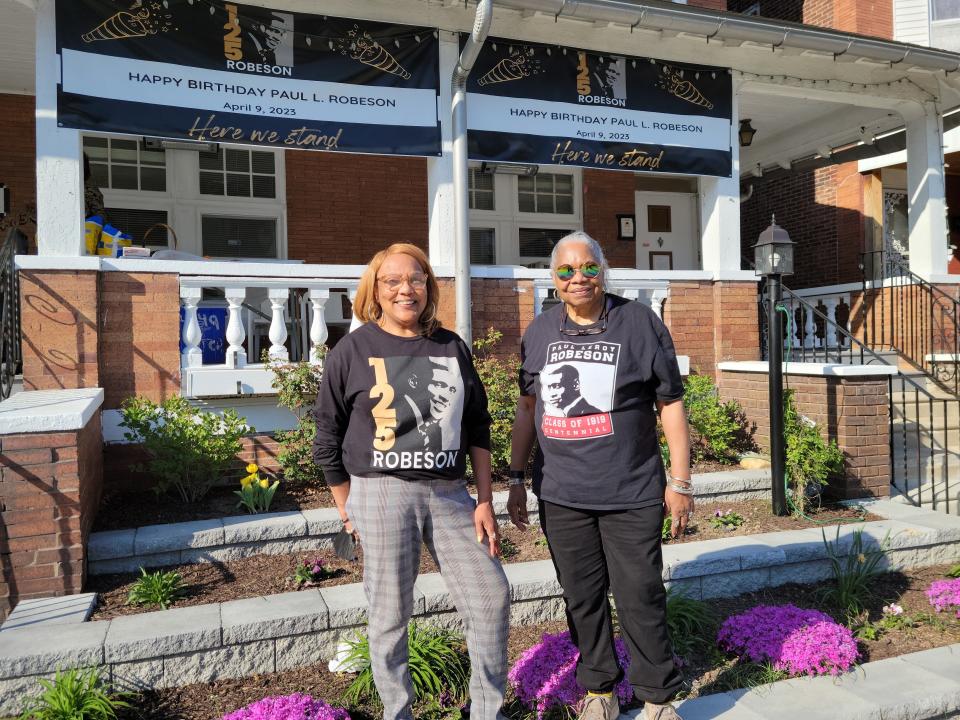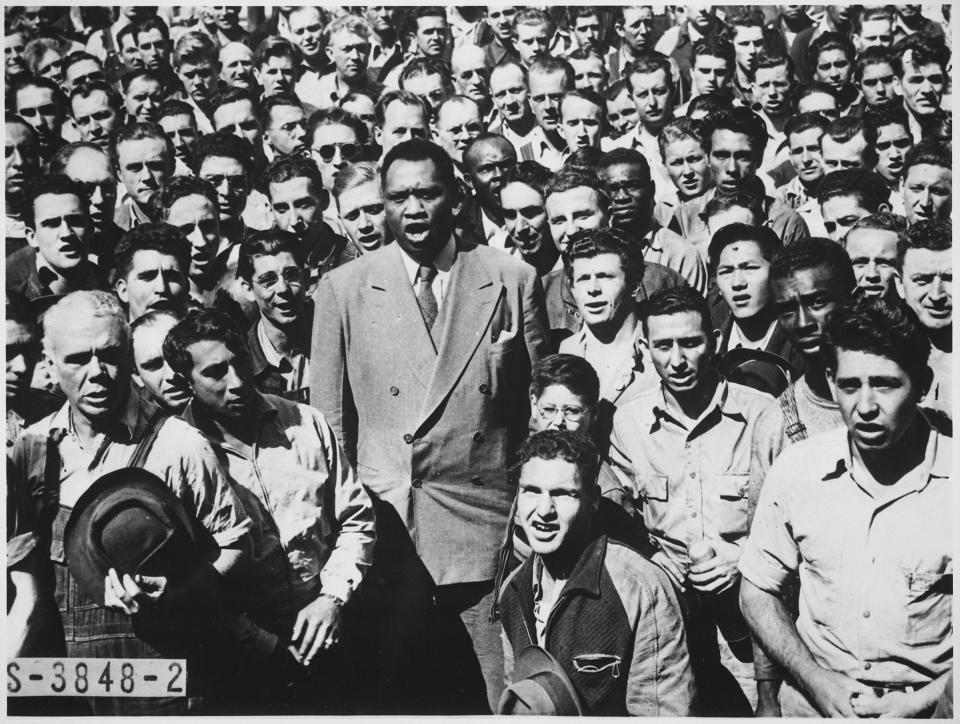Smeared, banned, exiled: Paul Robeson finally gets Philadelphia street in his name
- Oops!Something went wrong.Please try again later.
- Oops!Something went wrong.Please try again later.
- Oops!Something went wrong.Please try again later.
Vernoca Michael always loved trying to outrun the FBI. After buying herself a Camaro, she got pretty good at it.
“I was a young girl,” she said. “So I wanted to be dangerous.”
And if you lived on the 4900 block of Walnut Street in West Philly in the 1960s, one of the more dangerous things you could do was be friends with the dapper septuagenarian who lived across the street from her.
That man, Paul Robeson, was living as a near-recluse in a humble schoolteacher’s home. But once, he’d been among the most famous and revered men in the country and world.
Raised in Princeton, New Jersey, Robeson was among the first Black men in the country to play professional football. He became a trained lawyer, a 1930s movie star, a Shakespearean actor on the London stage and a singer with one of the most revered bass-baritone voices in American history.
In a ceremony this Friday, 125 years after his birth, he will be honored in Philadelphia with a street bearing his name.
His birthday, April 9, will be declared Paul Robeson Day in Philadelphia.
But to the powers that be beginning in the 1950s, Robeson was a pariah. His international activism and scathing criticism of racism in the United States had made him a suspected enemy of the state. He was discredited as a Communist sympathizer, subject to death threats, blacklisted for years from performing or even traveling out of the country.
Robeson was a voice to be silenced, effectively erased from history.
“He was the tallest tree in our forest,” said historian Gerald Horne, author of a book on Robeson. “It's not surprising that a mega-celebrity like him receives a mega-persecution when he is perceived to cross the line. Therefore, when there was an attempt to bring him down, he fell precipitously.”
Men in parked cars often sat in front of his house, Michael remembered, sometimes into the night — and indeed a decadeslong surveillance of Robeson is attested by thousands of pages of declassified FBI files.
Whenever young Michael took her famous neighbor out for a drive, a car always seemed to follow. And then she tested the limits of her Camaro.
“I would just take off,” she said, “and see where they’d follow me.”

Michael, now vice president of the nonprofit West Philadelphia Cultural Alliance, will be among those standing proudly as the sign for Paul Robeson Way goes up on the 4900 block of Walnut St. — conscious of what he sacrificed for his beliefs.
“With all that’s changing in our country,” she said, “it is good to remember a man who fought so valiantly for what we are enjoying today.”
From football to the silver screen, Paul Robeson a titanic figure in his day
It’s impossible to overstate how titanic a personage Robeson was during the first half of the 1900s, said Janice Sykes-Ross, executive director of the Paul Robeson House and Museum at Robeson's former home in Philadelphia. Robeson was a figure with few parallels today.
“Often with some of our students, we say, 'Who is the most famous person in the 21st century?' Some of them yell out Michael Jackson or Beyoncé. Or they'll say Barack Obama, but definitely the president of the United States,” she said. “And what we say to them is, take that person and multiply that person twice, and now you understand the notoriety and the fame.”
More: Score one for Rutgers: Paul Robeson, once shunned, is again Big Man on Campus
Born in 1898 to a schoolteacher and a minister father who’d escaped slavery in the South, Robeson rose to become valedictorian at Rutgers University, a gifted athlete hailed by Philadelphia sportswriter Robert Maxwell as “without a doubt, the best football player in the country.”
He went on to play pro football in a precursor to the NFL, but used the money to put himself through Columbia law school — then gave up his law career in protest after a stenographer refused to take dictation from a Black man.
Instead, he rose as an actor in the 1920s to the highest levels of theater: Eugene O’Neill wrote the title character in his play, “The Emperor Jones,” specifically for Robeson. In London, Robeson became the first Black man since 1860 to play Othello onstage, a role then often played in blackface. When Robeson reprised this role in New York, it became the longest-running Shakespeare production in Broadway history.
He also traveled the world as a singer, cutting best-selling recordings and singing in private audience to the Prince of Wales. He introduced booming-voiced spirituals to Greenwich Village intellectuals, while his films made a fan of poet Langston Hughes, in part because he refused stereotypical roles he found offensive.
His signature, perhaps, was “Ol’ Man River,” written for Robeson by Rodgers and Hammerstein for the musical “Show Boat.” His performance, immortalized in the 1936 film version, is cited by many as the definitive version of the song.
But in later live performances, Robeson changed the lyrics. He removed slurs and stereotypes. And he made the song a means to survival.
"I keeps laughin', instead of cryin'," went Robeson's version. "I must keep fightin', until I'm dyin'."
Robeson's civil rights activism, and subsequent blacklisting
The changes to Ol' Man River mirrored Robeson's own life. By the '30s he had become an omnipresent voice in international politics, leveraging his fame to advocate for worker rights and human rights all over the world. And in the process, he made as many enemies as friends.
He and his wife, Eslanda, fought against apartheid in South Africa before most Americans knew what it was — making a fan out of Nelson Mandela — and became a friend to the Nehru-Gandhi family of India. He campaigned against fascists in Spain and spoke out for Welsh coal miners. He also refused to denounce Communists, in part because he found Russia more hospitable to Black men than the country in which he was born.
Especially, he fought the racism he knew intimately in the United States. In 1946, he incensed President Harry Truman in a private meeting by demanding an anti-lynching law, lest Black Americans decide instead to “defend themselves" — a line that reportedly caused the president to break off the meeting.

But during the paranoia of the budding Cold War, Robeson’s downfall in the public eye was swift: At a Soviet-sponsored peace conference in Paris in 1949, Robeson had spoken about his desire for peace between the U.S. and Communist countries.
A writer for the Associated Press sent a report of Robeson's speech that's now believed a fabrication, reporting that Robeson had declared Black Americans would refuse to fight on the side of the United States against the Soviet Union.
Robeson, already under scrutiny for Moscow visits and Communist sympathies, was quickly blacklisted: Scores of concerts were canceled, he was left out of football record books, and the State Department revoked his passport for eight years.
Robeson’s recordings and movies were removed from circulation, and baseball star Jackie Robinson was asked to denounce Robeson in front of Congress.
Rather than be cowed, Robeson pushed back: He delivered a petition to the United Nations in 1951, charging that the history of lynchings in the United States amounted to genocide against Black Americans.
“Paul Robeson was sufficiently audacious to try to take the question of persecution of Black Americans into the international arena,” said historian Horne. “This was a tremendous black eye at a time when the United States was in a battle of ideas with the Soviet Union.”
Amid death threats, loss of income and a concert in New York attacked by a mob that lynched him in effigy, Robeson didn't relent or recant.
“My father was a slave, and my people died to build this country, and I am going to stay here and have a part of it just like you,” he told Congress in 1956. “And no fascist-minded people will drive me from it.”
Paul Robeson in Philadelphia, and the resurrection of his reputation
No one drove Robeson away, and he was able to tour again after his passport was returned in 1958.
But by the time he moved in 1966 to his sister's house in Philadelphia, a city that had long been central to his life, Robeson was living the life of an exile.
His home on Walnut Street nonetheless became a site of pilgrimage for a new generation of entertainers and civil rights leaders.
“Ossie Davis and Ruby Dee, Harry Belafonte, Lena Horne, the list goes on,” Michael said. “These people were told if they came here to Philadelphia to visit, their careers will be ruined. And yet time and time again these individuals came to visit, and they considered him like a father figure.”
Some kept visiting even after they received threats over their association with Robeson, Michael said.
But though he was still admired in many corners, Robeson's reputation would not be restored in public memory until decades after his death in 1976.
Sykes-Ross and Michael credit a former librarian named Frances Aulston for starting this work in Philadelphia — including the plan to purchase and restore Robeson’s home at 4951 Walnut St. to use as a museum. Aulston had also long campaigned to declare April 9 as Paul Robeson Day in Philadelphia.
“I think that while it was started some time ago, it has now finally come to fruition because all the right pieces have fallen in place,” Sykes-Ross said.
One part of this, Sykes-Ross said, is a new collaboration with other Paul Robeson sites in New York and New Jersey. The museum also received an important grant from the Mellon Foundation. And she found a sympathetic Philadelphia councilmember in Jamie Gauthier.
In February, Gauthier introduced a successful resolution to rename the 4900 block of Walnut Street after Robeson. On Thursday, April 13, she'll introduce another resolution to declare April 9 as Paul Robeson Day in Philadelphia.
And on Friday morning, Gauthier and the Paul Robeson House will hold a public ceremony to unveil the new street sign proclaiming Paul Robeson Way.
“I can't believe that we don't already have a street named for him,” Gauthier said. “He was doing this activism at a time when Black people were killed for that type of activism, and he had a whole lot to lose professionally and artistically. I think it just speaks volumes about his bravery, his resolve. And I think it's a legacy to be celebrated.”
Sykes-Ross knows this celebration feels a bit belated. But as she sees familiar fights over America’s racial history crop up again, it also feels relevant as ever.
“Is it late? Yes. Is it right on time? Yes, it's right on time as well,” she said. “Unfortunately, some of the fights that we were fighting back in the '60s or '70s, those fights are going in a circular motion. … And so now more than ever, the legacy of Robeson is important.“
The Paul Robeson House and Museum is celebrating Paul Robeson's 125th birthday with a series of events, including a street renaming ceremony on the morning of Friday, April 14, at 4951 Walnut St. Friday evening will offer a discussion panel about Robeson's influence on radical activism, while Saturday features a closing gala with Sankofa president Gina Belafonte and a capella ensemble Sweet Honey in the Rock. Details and tickets at paulrobesonhouse.org/125th-birthday-celebration.
This article originally appeared on USA TODAY NETWORK: Once exiled, blacklisted, Paul Robeson now gets Philadelphia street

